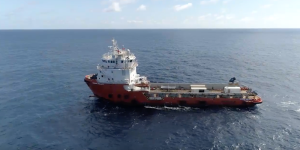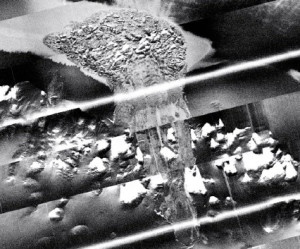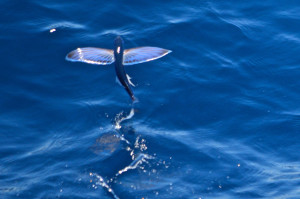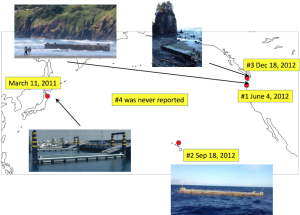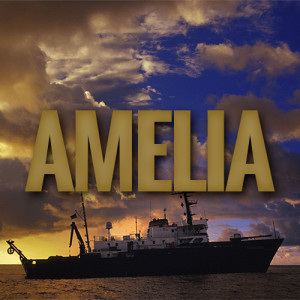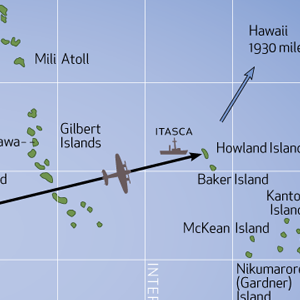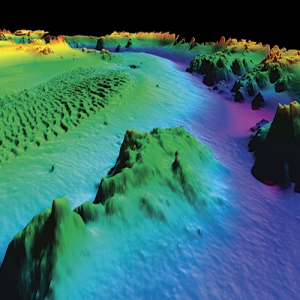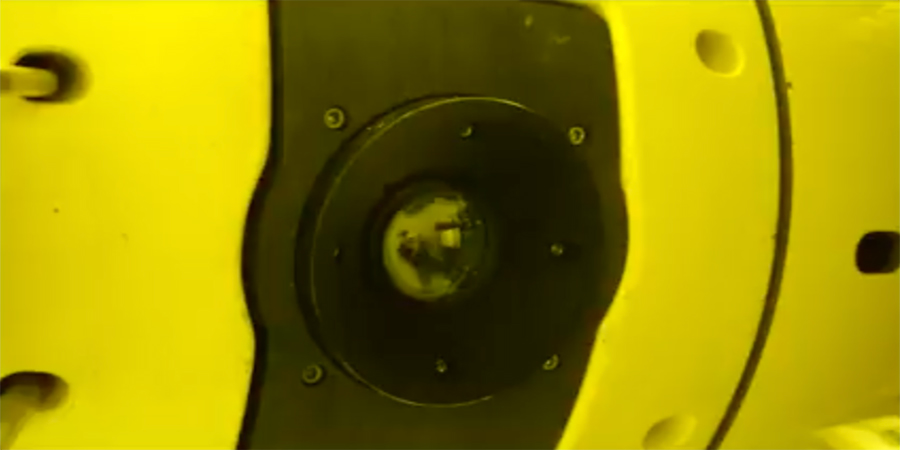
Meridian Passages, Volume XIII, Number 17
Central Pacific Edition
Hoops Showdown
Vigilance Victorious in Central Pacific B-Ball Challenge

The Mermaid Vigilance All-Star Team of Ikhsan “Shark Attack” O’Neil, Mardan “Blue Bear” Jordan, and Noe “El Capitán” Rodman streaked to victory today in a much anticipated and hotly contested matchup at the Aft Deck Arena. The undefeated visiting HooeyKnots may have suffered from overconfidence, as “Layup” Lorraine, “Not Michael” Jourdan, and “Pick & Roll” Packard could not match the scrappy play of the hometown favorites.
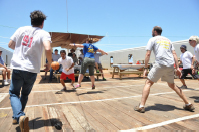
Lorraine scored first, and a second basket by Packard gave the ‘Knots an early lead. But it was not to last, as the All Stars kept up he pressure and soon took control. Coach “Spider” King called a timeout and pretended to draw up a play, hoping to trick his opponents into thinking the ‘Knots knew what they were doing. The tactic failed as the home team schooled them in what “home court advantage” means.
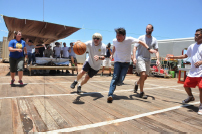
They cleverly bounced the ball off vent covers, railings, and even off the spectators to the frustration of the visitors, and finished off the “Knots with an 8-5 score. The record low tally was attributed to a particularly nasty swell and (face it) profoundly poor shooting as both teams missed repeatedly from point blank range.
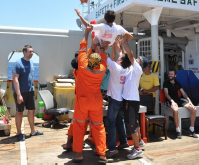
In defeat, the HooeyKnots and their fans stood at center court and sang their chosen song of hope and redemption, “Row, Row, Row Your Boat” to the quizzical looks of the Mermaid fans.
In a post-game interview, ‘Knots power forward Jourdan attributed the outcome to bad coaching, improper ball inflation, and incompetent officiating. HooeyKnot fans were clearly not pleased; one complained the referee was dishonest. There was no comment from the league, though referee Joe “Popeye” Litchfield said in his opinion the HooeyKnots were a “bunch of half-witted high tide clam diggers.”

Noe “El Capitán” Rodman praised his teammates and graciously gave the HooeyKnots credit for a good effort and nice hair. Meanwhile, rumors swirled around accusations that some inducement was offered to the referee to “keep it fair.” The source went on to say he threw the money back after the game saying something about it was “not enough.”
What’s next for the HooeyKnots? Will there be a rematch? Will free agent Lorraine hold out for a bigger contract and a supply of styrofoam cups? Will Packard be traded for transponder floats? The coming weeks will tell.
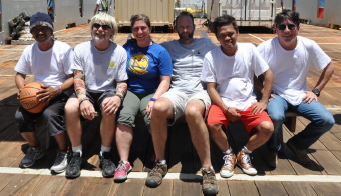
Nauticos News Night 6 — Tour of Mermaid Vigilance 1
It’s News Night on Mermaid Vigilance! Tour the vessel with “Captain” Joe Litchfield as Nauticos and the Eustace Earhart Discovery Expedition team search the Central Pacific for Amelia Earhart’s lost Lockheed Electra.
Meridian Passages, Volume XIII, Number 16
Central Pacific Edition
Living History
Carl Panhorst, Itasca Helmsman
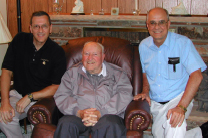 In June 2005, a documentary program on our Earhart project aired on the Travel Channel. After seeing that program, Rose Pierson contacted Nauticos about her father Rufus and her Uncle Carl Panhorst being crew members of the Coast Guard Cutter Itasca during Amelia Earhart’s flight July 2, 1937. A few days later Tom Vinson and I placed a call to Carl.
In June 2005, a documentary program on our Earhart project aired on the Travel Channel. After seeing that program, Rose Pierson contacted Nauticos about her father Rufus and her Uncle Carl Panhorst being crew members of the Coast Guard Cutter Itasca during Amelia Earhart’s flight July 2, 1937. A few days later Tom Vinson and I placed a call to Carl.
Carl started the interview b y emphatically stating “Well, let me tell you boys something – I’m 91 years old and still have all my marbles.” I looked at Tom and we both knew this was going to be good.
Carl related how he was a crewman on Itasca that fateful day when Amelia Earhart disappeared somewhere near Howland Island. He had galley duty that morning and had to stay behind on the ship while all his mates went ashore to assist with Earhart’s anticipated landing on Howland. So when Carl finished in the galley, he went up and stood on deck outside the open hatch to the radio room and listened to Earhart’s radio transmissions.
We were incredulous at this tale unfolding over the phone for we realized we were most likely speaking to the last person alive to have heard those radio transmissions. Tom asked Carl a few more questions. Then, as Carl was describing the search activities of the Itasca, he said “I’ve got pictures too!”
“You do?!” I asked.
“Yep”
At this point I knew we had to visit Carl, so I asked “Can we come out and see you?”
“Sure …. I’m not going any place” was Carl’s response.
About 10-days later, I’m in Minneapolis attending my youngest son’s second college graduation ceremony when Tom called and said he has a business trip to Arizona in two days . Quickly he changed his ticket to leave a day early with a stop in Salt Lake City, Utah. I commandeered one of the college computers and quickly booked a ticket. After the graduation, it was a fast trip home to pack a bag and run to the airport.
On the way home, I stopped long enough to buy a video camera and a portable scanner to take along. I arrived at Salt Lake City on time, collected my bag and met Tom. We caught the shuttle bus to the hotel.
It’s deja vu all over again: the hotel is on Amelia Earhart Drive. In fact, we eat supper in the Amelia Grill at the nearby Holiday Inn.
The next morning, Carl’s niece Rose Pierson with her mother Marie, picked us up and we drove an hour to Carl’s house in Provo.
We were welcomed by Carl and Wanda, his wife of 65 years, their two sons, Dan and Chuck and Dan’s wife Hilda. Lee Benson, a reporter from the Desert News was also there. It was an atmosphere of high anticipation. Tom and I explained a just bit about our project but withheld details until after we interviewed Carl as we wanted his recollections untainted by what we think. Carl re-iterated what he told us on the telephone earlier: He’s over 90, has all his marbles, doesn’t wear hearing aids, nor does he wear glasses (never did). I also observed he didn’t need a cane to get around the house. This was even more remarkable after we learned what happened to him in WWII.
We videotaped the interview with Carl for nearly 2 hours then took a break for juice and muffins. During the break and with my video tape recorder off (unfortunately), I casually asked Carl if he stayed in the Coast Guard or what he did in the years afterward.His reply was “No, I got out and got a job with the US Postal Service in Los Angles.” “But then the Japs bombed Pearl Harbor and I got drafted.” This grabbed my attention and I asked “So where did you serve – In the Pacific?”
 “No, I was in the Army Infantry and was sent to Europe” “And where in Europe?” I asked “Oh, I was all over….. I was in the battle of the Hurtgen Forest and was wounded there.” I asked how it happened.
“No, I was in the Army Infantry and was sent to Europe” “And where in Europe?” I asked “Oh, I was all over….. I was in the battle of the Hurtgen Forest and was wounded there.” I asked how it happened.
Carl very nonchalantly replied “Well we were dug-in and the Germans were shelling us for two days. At one point a shell landed near a fellow in a nearby foxhole and severely wounded him. We could hear him screaming in pain so I says to my buddy ‘We’re probably going to get it next. We might just as well be doing something useful when it happens, so let’s go get him’!
“So we jump out of our hole, run over and pick him up and we’re carrying him back to the medics when a shell burst behind us. The next thing I remember is lying on the ground with a blanket over my face. I started yelling ‘I’m alive…. I’m alive!’ A medic came over and pulled the blanket off me. I had shrapnel wounds in my shoulders and back and spent the next 9 months in hospitals.”
I thought to myself “What a tough guy (and lucky) to be wounded so badly in his youth and yet walk around at age 91 without even the use of a cane.” Meeting people like Carl Panhorst and hearing their remarkable stories is one of the most fascinating aspects of the Earhart Project. Carl passed away on Jan. 6, 2008 at age 93. It was both an honor and privilege to have known this great man.
— Rod Blocksome
Meridian Passages, Volume XIII, Number 15
Central Pacific Edition
Thanks to hard work and good performance by REMUS OPS, we are being treated to some amazing imagery from the bottom of the ocean. A particularly dramatic example of what is probably an undersea landslide is shown here. Several sonar passes were made over this area with each swath overlapping. After the REMUS collected the data, Jeff merged it together with navigation to make a mosaic, yielding the composite image shown here.
 To get an idea of the scale of this feature, the spacing between the light stripes running across the scene is 1,100 meters (0.6 nm). That makes the pile of rubble at the top of the screen about a half mile across. The stripes represent the nadir of the sonar (line directly below) where imagery is poor. We overlap swaths to be sure to cover everything.
To get an idea of the scale of this feature, the spacing between the light stripes running across the scene is 1,100 meters (0.6 nm). That makes the pile of rubble at the top of the screen about a half mile across. The stripes represent the nadir of the sonar (line directly below) where imagery is poor. We overlap swaths to be sure to cover everything.
As interesting as this terrain is, we are hoping to avoid a lot of rough bottom, as crevices and craters can hide our target. Also, steep ridges can be a hazard for the AUV as we try to skim the sonar just off the bottom. However, we must take what the sea will give us, and these topographic features are not only interesting, but provide some geographic “tie points” to help us assess our navigation accuracy and to ensure we line up with older data. Fortunately, the vast majority of the seafloor in this region is quite flat and featureless, and the Electra should stand out clearly when we image it.
Operations Summary
Mission 007 concluded yesterday morning and Mission 008 started after a swift turnaround. Two notable improvements were achieved. The battery pack service life was extended to permit more lane coverage per mission, meaning more survey time available. And the on deck service interval was reduced by a significant amount, meaning more survey time available. All of this speaks well for the teamwork that is evident out here. Well done everyone!
S/V Sauvage Arrival Imminent:
The meeting at sea of the sailing vessel Sauvage and Mermaid Vigilance is planned for Sunday. A personnel transfer by small boat will occur in which explorer Alan Eustace will join the team and participate in the mission for a number of days. Alan has come all the way from California to be with us. Be sure to welcome him aboard.
We’ll also host a visitor, Nino Wattrelot, crewmember of Sauvage and licensed engineer in the megayacht industry. He asked for a tour of the Mermaid and to have a look at the technology we use. A lifelong sailor, Nino was raised on sailing yachts. He has traveled extensively around the Pacific. You are encouraged to chat with Nino – just remember security at all times, “You are not free to discuss details of the operation.”
Meridian Passages, Volume XIII, Number 14
Central Pacific Edition
Wildlife Issue
What’s Out Here
 Ornithologically speaking, this place is for the birds! Boobies and terns, mainly. Boobies most likely get their name from the Spanish word bobo, meaning dunce. Boobies had the unfortunate (for them) habit of landing on sailing ships. Since they had no fear of humans they quickly became part of the evening meal.
Ornithologically speaking, this place is for the birds! Boobies and terns, mainly. Boobies most likely get their name from the Spanish word bobo, meaning dunce. Boobies had the unfortunate (for them) habit of landing on sailing ships. Since they had no fear of humans they quickly became part of the evening meal.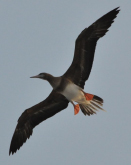
Fish are also flying around in profusion. We see them skimming the wavetops ahead of our bow. Rumor has it a wahoo was observed the other day, but we’re not telling since fishing is not allowed on Vigilance. We will tell about the huge squid that are attracted to the bright lights astern during REMUS recoveries.

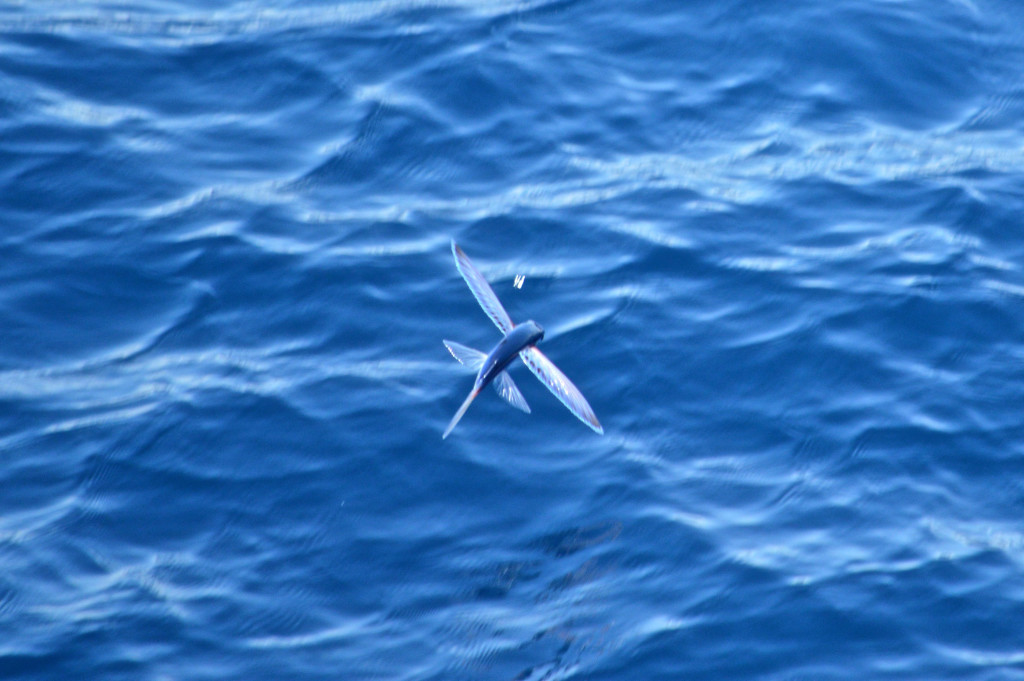 Of course the focus of our endeavors is well below the waves, and we are lucky to have a chance to see what’s down there, thanks to REMUS. Though we are mainly engaged in a sonar search for now, we did test out the camera on a sortie and managed to capture a few deep sea critters. Common on the seafloor here are acorn worms, which have no bones, no eyes and no brains with soft and gelatinous bodies. They crawl over the surface of the mud slurping the sediment and excreting a trail behind them. Yuck.
Of course the focus of our endeavors is well below the waves, and we are lucky to have a chance to see what’s down there, thanks to REMUS. Though we are mainly engaged in a sonar search for now, we did test out the camera on a sortie and managed to capture a few deep sea critters. Common on the seafloor here are acorn worms, which have no bones, no eyes and no brains with soft and gelatinous bodies. They crawl over the surface of the mud slurping the sediment and excreting a trail behind them. Yuck.
 The specimen here and the other seafloor photos here were captured by REMUS at a depth of greater than 18,000 feet.
The specimen here and the other seafloor photos here were captured by REMUS at a depth of greater than 18,000 feet.
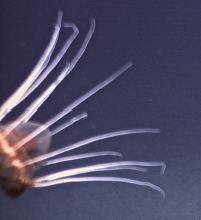 The helmet jelly is found in every ocean of the world except the Arctic, as deep as 7,000 meters (23,000 feet). They are 90% water and the rest is tissue and a gelatinous mass. They light themselves from within with bioluminescence.
The helmet jelly is found in every ocean of the world except the Arctic, as deep as 7,000 meters (23,000 feet). They are 90% water and the rest is tissue and a gelatinous mass. They light themselves from within with bioluminescence.
Umbrella octopuses have a web of skin between the tentacles. They swim up above the ocean floor, spread their tentacles and float down collecting food looking like an opened umbrella.

 The octopus above is seen upside down, probably skittering away from the AUV. We look forward to seeing more exotic creatures of the deep the next time we turn on REMUS’s cameras.
The octopus above is seen upside down, probably skittering away from the AUV. We look forward to seeing more exotic creatures of the deep the next time we turn on REMUS’s cameras.
—Sue Morris
Meridian Passages, Volume XIII, Number 13
Central Pacific Edition
Shooting the Stars
The Arcane Art of Celestial Navigation
 On our last expedition Spence had the idea that he and I (with part-time help from many other folks) should navigate to Tarawa using only the ship’s course by compass, speed by engine setting, and the sky. No GPS or other electronic means, other than using the clock for accurate time. This is more or less equivalent to the state-ofthe- art of navigation around the time of World War II, and it’s useful as an exercise because we often deal with data from that era. It’s also fun in a nerdy sort of way.
On our last expedition Spence had the idea that he and I (with part-time help from many other folks) should navigate to Tarawa using only the ship’s course by compass, speed by engine setting, and the sky. No GPS or other electronic means, other than using the clock for accurate time. This is more or less equivalent to the state-ofthe- art of navigation around the time of World War II, and it’s useful as an exercise because we often deal with data from that era. It’s also fun in a nerdy sort of way.
I found that being an old-time ship’s navigator was a full-time job (and I wasn’t standing watches during the transit). A lot of it involves “shooting a fix,” using a sextant to measure the altitude (height above the horizon) of a star, sun, moon, or planet, and using tables of orbital data to calculate a ship position. The sextant works by projecting an image of a part of the sky onto another image of the horizon, with an adjustment to move the projected image in altitude. You adjust until the image of the star just touches the image of the horizon, and read the angle between the projected images off the dial. You can measure reliably down to one arc-minute (1/60th of a degree) using this instrument.
The basic principle is simple. Through astronomical observations, we know very accurately the positions of the stars, sun, moon and planets at any time. We can project the location of a particular object onto the surface of the Earth at any particular moment, known as the Geographic Position (GP). If we are at that exact position, that object would be directly overhead (that is, at an altitude of 90 degrees). If we are away from that point, the altitude will be lower, and we can use the observed altitude (measured with the sextant) to compute our distance from that GP. If we plotted the GP on a globe, and drew a circle around it with radius equal to that distance, we would be somewhere on that circle.
In practice, since we have some idea where we are in the world, we only need to draw the part of that circle that passes near our assumed location, which is a “line of position” (LOP). If we do this with three or more objects, we get several lines, all of which should pass through our position, and when we plot them, we get a position fix. Of course, there are lots of details to correct for, and the computation itself is a bit arcane, and time consuming.
Well, we found Tarawa last expedition, and heady with success, we decided to try our hand at some star fixes out here. The results were pretty good as we got an excellent fourstar fix that compared beautifully with GPS. However, it took us about 3 hours of ciphering and most of an eraser to puzzle out the answer. We’ll give ourselves a B+.
OPERATIONS SUMMARY:
Vehicle Mission 06 has REMUS on deck at 0500 for a routine turnaround service. Deck teams will be busy in the morning. REMUS will start mission 07 late in the morning. SEA School and the Daily Progress Report will be held in the afternoon.
Meridian Passages, Volume XIII, Number 12
Central Pacific Edition
WANTED: Wet or Dry
The Floating Dock that Eluded Capture in the Pacific for 6 Years
On March 11, 2011, an earthquake in Japan registering 9.0 on the Richter Scale shook the world. A tsunami event was generated sending walls of water over jetties and levees into seaside towns and villages along the Japanese coast. The toll of death and destruction was devastating. Officially over 15,893 persons killed, 6,152 injured and 2,567 missing. Property losses were enormous . The Japanese Ministry of Environment estimated that 4.8 million tons of tsunami debris washed into the North Pacific; 68 percent sank and 32 percent remained adrift.
The city of Misawa Japan lost four sections of its steel floating dock each 60 feet in length. Three of these sections were later found in 2012 on the shores of Hawaii, Washington and Oregon. There is one that remains undetected. It is suspected to be in the Central Pacific region in an area near the Republic of Marshall Islands. You’re right if that’s where you think we’re going next. If it is found, researchers want to tag it to that it can be tracked and eventually captured for scientific study. Alan Eustace, who will be joining us in a few days, will be bringing satellite tracking devices for this purpose. So if we encounter this runaway, we are equipped to tag it and bag it.
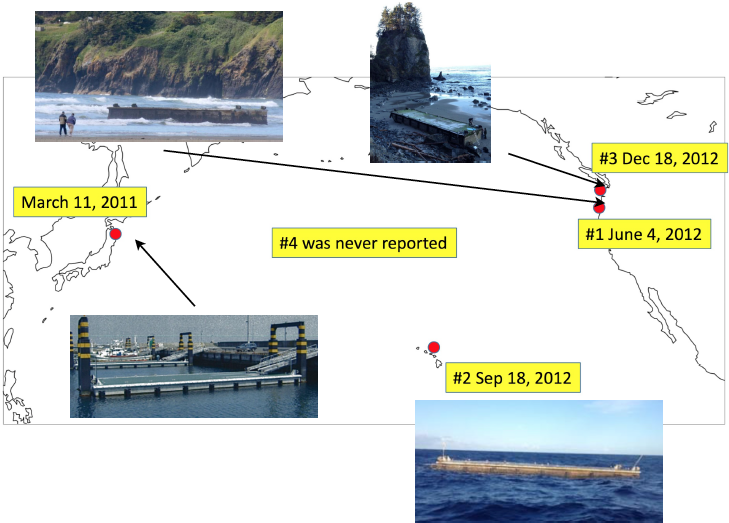 Researchers have already found about 70 species of seaweeds and 240 species of invertebrates and microorganisms living on debris, primarily along Washington and Oregon where most of the work is concentrated. Some of the species are known only from Asia, especially Japan; some naturally occur on both sides of the Pacific; some were previously introduced to North America; some are non-native to Japan; others require more study. Scientists appreciate that even one invader has the potential to cause serious environmental and economic harm. Yet history also shows that most exotics coexist with native species without becoming pests, at least in the short term. Identifying potential insurgents is the daunting challenge, given the continent’s vast, corrugated coastline and the certainty of more debris yet to come.
Researchers have already found about 70 species of seaweeds and 240 species of invertebrates and microorganisms living on debris, primarily along Washington and Oregon where most of the work is concentrated. Some of the species are known only from Asia, especially Japan; some naturally occur on both sides of the Pacific; some were previously introduced to North America; some are non-native to Japan; others require more study. Scientists appreciate that even one invader has the potential to cause serious environmental and economic harm. Yet history also shows that most exotics coexist with native species without becoming pests, at least in the short term. Identifying potential insurgents is the daunting challenge, given the continent’s vast, corrugated coastline and the certainty of more debris yet to come.
What is Meridian Passages?
For our search expeditions, Spence suggested that we have a daily ship’s “newspaper,” seeing it as a good way to promulgate details of the ship’s schedule (the Plan of the Day). We saw it as a fun way to get people on the ship involved with each other, to help document the experience, and provide some working material for the Education Team. Thus was born Meridian Passages, Central Pacific Edition.
Passages was a newsletter we had been publishing at Nauticos since 1997, starting back when our company operated under the name Meridian Sciences, Inc. I coined the title Meridian Passages as sort of a triple pun. Our company name was Meridian; a passage is a story, and a meridian passage is the passing of a heavenly body (like the sun, moon, or a star) across one’s meridian of longitude. Hence, the meridian passage of the sun is another name for “noon,” and it is the moment when a body is highest in the sky. The astronomical reference appealed to me, as an amateur astronomer operating a company whose specialties included the science of navigation.
So, the first edition of Volume XIII of Meridian Passages was issued on the day after we got under way. It features news of the day, the official Plan of the Day, a Spotlight on a crew member, a story or article, and a mock “Classifieds” section for fun.
Anyone can contribute, but we rely heavily on Reporter Marika for interviews, Teacher Sallie for SEA School, Photographer Sue for images, Spence for Plan of the Day, Joe for sea stories, and Bethany for layout. They and others have contributed articles and ideas for Classifieds. Of course, whatever happens out here is raw material.
Our first issue was received with raised eyebrows and puzzled looks. But after a few days, folks would come looking if we didn’t roll the presses by our self-imposed deadline.
— Editor.
Meridian Passages, Volume XIII, Number 10
Central Pacific Edition
Operations Begin
First Sortie Completed
 The REMUS AUV returned to the surface on schedule, having completed its first sortie as assigned. In spite of a little more wind than predicted and some mixed seas, the recovery was flawless. Ship’s crew, the REMUS OPS team, and Nauticos personnel all worked together to get the vehicle on board smartly. Everyone not assigned a job watched from various vantage points, and Bill filmed the whole operation, of course. Data download was begun and initial review showed all sensors worked as designed. Jeff & Tom continued to review the data and Greg & his team began to ready the system for its second sortie. It will be on its way back to the bottom to continue the search in short order.
The REMUS AUV returned to the surface on schedule, having completed its first sortie as assigned. In spite of a little more wind than predicted and some mixed seas, the recovery was flawless. Ship’s crew, the REMUS OPS team, and Nauticos personnel all worked together to get the vehicle on board smartly. Everyone not assigned a job watched from various vantage points, and Bill filmed the whole operation, of course. Data download was begun and initial review showed all sensors worked as designed. Jeff & Tom continued to review the data and Greg & his team began to ready the system for its second sortie. It will be on its way back to the bottom to continue the search in short order.
While the AUV was on the bottom, the team was busy extending the transponder pattern to cover the next areas.
Alan Eustace
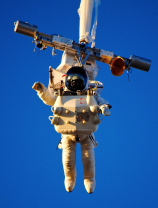
Inventor, Pilot, Explorer, Leader Alan Eustace, with a doctorate in computer science From the University of Central Florida, has led developments in pocket computing and computer architecture, and most recently retired from Google as Director of Knowledge. A pilot, skydiver, and adventurer, Alan made history in 2014 with a record breaking near-space dive from the stratosphere at 135,890 feet. Free-falling over 23 miles, he reached a speed of 821 mph (breaking the sound barrier at Mach 1.3) before slowing in the thickening atmosphere and parachuting safely to earth. His spacesuit and support equipment went on permanent exhibit at the Smithsonian Air and Space Museum on December 15, 2016. With his support of the Amelia Earhart search expedition, Alan is setting his sights on new discoveries. He will join the expedition team at sea in a few days.
Down to Rockland Way
A Cap’n Joe Sea Story
… continued from yesterday.
Down to Rockland Way In the last installment, Cap’n Joe described the events surrounding Old Joe Manley’s legendary swim. The story continues at Sangillo’s Tavern, Portland Maine, two years later: Before losing their liquor license because of too many outgoing 911 calls, Sangillo’s was the place to go to as a fisherman. Always an ol’ dory mate around to buy you a beer when you were between sites, or just someone to swap sea stories with. By this time Old Man Manley was indeed a legend in his own time for his get-aboard the Why Must He Suffer swim at the Rockland jetty – why there was even some talk of re-naming that Jetty after him, by golly! I was in Sangillo’s when Ol’ Manley came in one late morning and he had a bit of a port list aboard already. Actually, he very seldom had both oars in the water, anyway. We settled into our usual scenario: Me buying shots and beers and him drinking them.
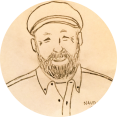 After a while Ol’ Manley went to the head to pump bilges and when he returned he sat down close abeam and said in a low voice: “Joe, I’ve got to confess.” I couldn’t imagine what in the Sam Hill he could have on mind so I didn’t say anything. Then he sprung in on me like a fouled-up tub trawl: “I was on the ol’ MustHe all the time that day back in Rockland — I can’t hardly swim a lick, much less catch a fish boat!” Well after my inevitable question of “How’d you do it?” He responded with a twinkle or maybe a tiny tear — hard to tell with Old Man Manly — in his eye:
After a while Ol’ Manley went to the head to pump bilges and when he returned he sat down close abeam and said in a low voice: “Joe, I’ve got to confess.” I couldn’t imagine what in the Sam Hill he could have on mind so I didn’t say anything. Then he sprung in on me like a fouled-up tub trawl: “I was on the ol’ MustHe all the time that day back in Rockland — I can’t hardly swim a lick, much less catch a fish boat!” Well after my inevitable question of “How’d you do it?” He responded with a twinkle or maybe a tiny tear — hard to tell with Old Man Manly — in his eye:
“Ya, I did indeed go down the pier that mornin’ just as soon as you and Boy went ta the Nor’d. I put ‘er the conner right for the Hotel Bar, got myself a fifth of ol’ Doctor Green and beat feet back to the MustHe. Then I went down in the lazarette*, snubbed-up the hatch cover and proceeded to take the edge off with my Doc G figurin’ everything was hunky-dory. But then I musta fell asleep I reckon ‘cause the next I know the shaft’s a turnin’ and the rudder’s a squeakin’. So I come up otta there and you fellas wasn’t around so I took that ol’ deck hose and give myself a dousin’ then come up with that there swimmin’ yarn and went into the galley to spin it. You know the rest, now don’t ya.”
Ol’ Man Manley Doherty went to Davy Jones back in ’79 I think it was, and this is the first time this story has ever been told to my knowledge. But who knows how many times he may have “confessed” for a taste of the demon rum.
Best Reg’rds, Cap’n Joe
*The lazarette on a fish trawler is a crawl space for gear storage and the steering arms.


